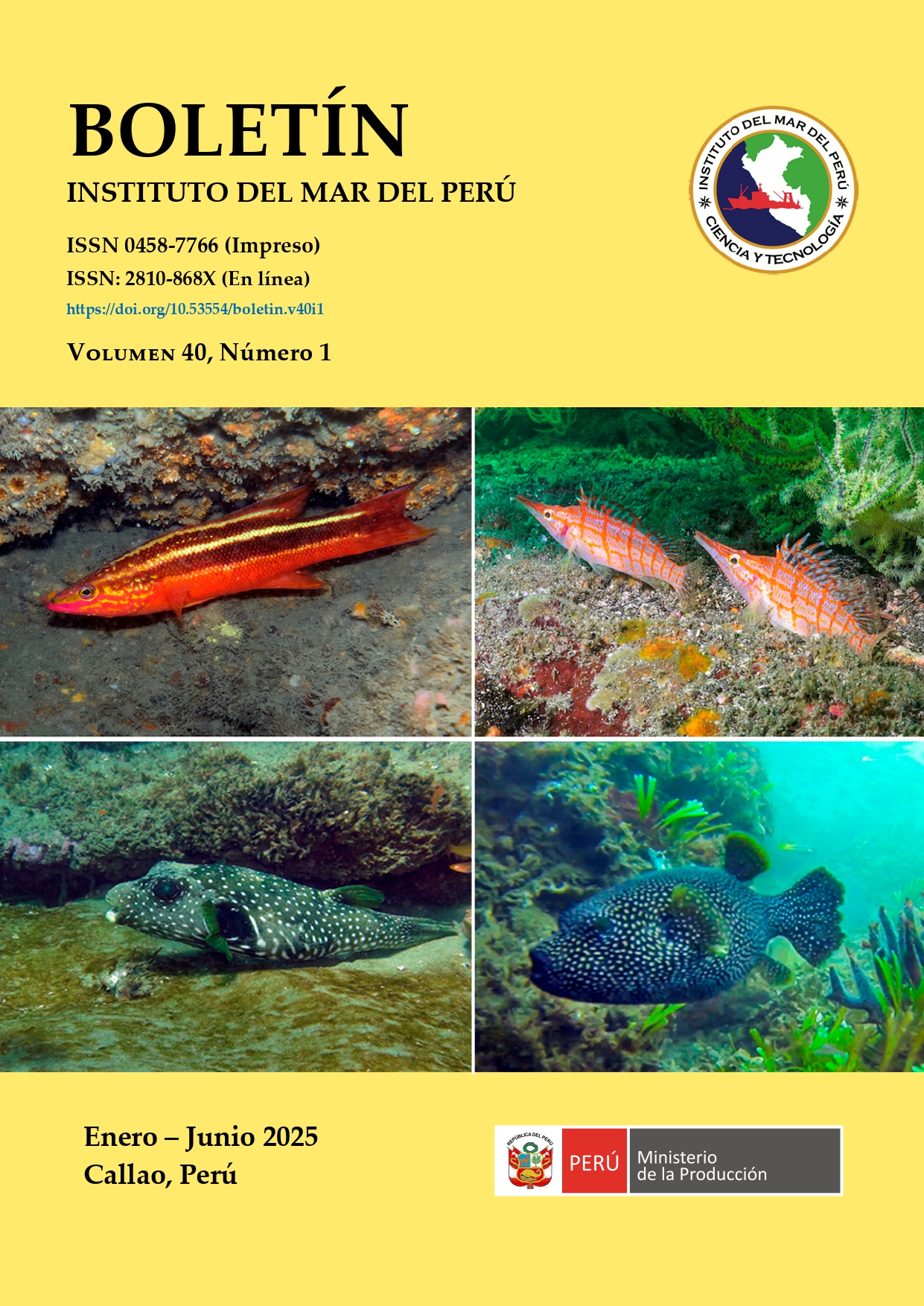Estimation of missing daily Sea Surface Temperature data, IMARPE coastal laboratories
DOI:
https://doi.org/10.53554/boletin.v40i1.431Keywords:
Daily data estimation, Multiple Regression, Segmented Multiple RegressionAbstract
The in situ Sea Surface Temperature (SST) records collected by IMARPE’s coastal laboratories constitute one of the most
extensive daily time series of oceanographic variables available for the Peruvian coast. These datasets are critical for oceanographic research and for monitoring large-scale climate events such as El Niño and La Niña. However, gaps in the daily records persist at several stations, making the development of consistent climatologies and long-term trend analyses difficult. This study aims to estimate missing daily in situ SST values using satellite-derived daily SST as a predictor within a linear statistical framework. Two methods have been applied and evaluated: Multiple Linear Regression (MLR) and Segmented Multiple Linear Regression (SMLR). The analysis shows that satellite SST can effectively serve as a predictor for the reconstruction of in situ SST time series. Among the approaches tested, PMLR provided more robust estimates, particularly for the coastal stations of Chicama, Chimbote, Huacho, Callao and Ilo. The resulting gap-filled time series improve the continuity and reliability of historical SST datasets for climatological assessments and operational monitoring.
Downloads
Alternative Metrics
Metrics
References
Bachelery, M.-L., Illig, S., & Dadou, I. (2016). Interannual variability in the South-East Atlantic Ocean, focusing on the Benguela Upwelling System: Remote versus local forcing. Journal of Geophysical Research: Oceans, 121, 284–310. https://doi.org/10.1002/2015JC011168
Chambers, J. M. (1992). Linear models. In J. M. Chambers & T. J. Hastie (Eds.), Statistical Models (Cap. 4). Routledge. https://doi.org/10.1201/9780203738535
Chin, T. M., Vazquez-Cuervo, J. & Armstrong, E. M. (2017). A multi-scale high-resolution analysis of global sea surface temperature. Remote sensing of environment, 200, 154-169. https://doi.org/10.1016/j.rse.2017.07.029
Demarcq, H. & Faure V. (2000). Coastal upwelling and associated retention indices derived from satellite SST. Application to Octopus vulgaris recruitment. Oceanologica Acta, 23(4), 391–408. https://doi.org/10.1016/S0399-1784(00)01113-0
Donlon, C. J., Martin, M., Stark, J., Roberts-Jones, J., Fiedler, E. & Wimmer, W. (2012). The Operational Sea Surface Temperature and Sea Ice Analysis (OSTIA) system. Remote Sensing of Environment, 116, 140-158. https://doi.org/10.1016/j.rse.2010.10.017
Grados, C., Chaigneau, A., Echevin, V. & Dominguez, N. (2018). Upper ocean hydrology of the Northern Humboldt Current System at seasonal, interannual and interdecadal scales. Progress in Oceanography, 165, 123–144. https://doi.org/10.1016/j.pocean.2018.05.005
Huang, B., Liu, C., Banzon, V., Freeman, E., Graham, G., Hankins, B., Smith, T. & Zhang, H-M. (2021). Improvements of the Daily Optimum Interpolation Sea Surface Temperature (DOISST) Version 2.1. Journal of Climate, 34, 2923-2939. https://doi.org/10.1175/JCLI-D-20-0166.1
Hyndman, R. J. & Athanasopoulos, G. (2018). Forecasting: principles and practice (2a ed.). OTexts.
Illig, S., Dewitte, B., Goubanova, K., Cambon, G., Boucharel, J., Monetti, F., Romero, C., Purca, S. & Flores, R. (2014). Forcing mechanisms of intraseasonal SST variability off Central Peru in 2000–2008. Journal of Geophysical Research: Oceans, 119, 3548–3573. https://doi.org/10.1002/2013JC009779
Mason, S. J. & Baddour, O. (2008). Statistical modelling. In A. Troccoli, M. Harrison, D. L. T. Anderson & S. J. Mason (Eds.), Seasonal climate: Forecasting and managing risk (NATO Science Series 82, pp. 163-201). Springer. https://doi.org/10.1007/978-1-4020-6992-5_7
Muggeo, V. M. R. (2003). Estimating regression models with unknown break-points. Statistics in Medicine, 22, 3055-3071. https://doi.org/10.1002/sim.1545
Minnett, P. J. (2014). Sea Surface Temperature. In E. G. Njoku (Eds.). Encyclopedia of Remote Sensing. Encyclopedia of Earth Sciences Series (pp. 754-759). Springer. https://doi.org/10.1007/978-0-387-36699-9_166
NOAA’s Pacific Marine Environmental Laboratory [NOAA]. (2014). Ferret (Version 6.9) [Software]. National Oceanic and Atmospheric Administration. https://ferret.pmel.noaa.gov/Ferret
National Oceanic and Atmospheric Administration [NOAA]. (2025a). El Nino regions. National Weather Service Climate Prediction Center. Recuperado el 20 de marzo de 2025, de https://www.cpc.ncep.noaa.gov/products/analysis_monitoring/ensostuff/nino_regions.shtml
National Oceanic and Atmospheric Administration [NOAA]. (2025b). Cold & Warm Episodes by Season. National Weather Service Climate Prediction Center. Recuperado el 20 de marzo de 2025, de https://origin.cpc.ncep.noaa.gov/products/analysis_monitoring/ensostuff/ONI_v5.php
Quispe-Ccalluari, C., Tam, J., Demarcq, H., Chamorro, A., Espinoza-Morriberón, D., Romero, C., Dominguez, N., Ramos, J. & Oliveros-Ramos, R. (2018). An index of coastal thermal effects of El Niño Southern Oscillation on the Peruvian Upwelling Ecosystem. International Journal of Climatology, 38(7), 3191-3201. https://doi.org/10.1002/joc.5493
Reynolds, R. W., Smith, T. M., Liu, C., Chelton, D. B., Casey, K. S. & Schlax, M. G. (2007). Daily high-resolution blended analyses for sea surface temperature. Journal of Climate, 20, 5473–5496. https://doi.org/10.1175/2007JCLI1824.1
Yu, J.-Y. & Kim, S. T. (2012). Identifying the types of major El Niño events since 1870. International Journal of Climatology, 33, 2105–2112. https://doi.org/10.1002/joc.3575
Downloads
Published
How to Cite
Issue
Section
License
Copyright (c) 2025 Boletin Instituto del Mar del Perú

This work is licensed under a Creative Commons Attribution-NonCommercial-ShareAlike 4.0 International License.










